You’ll verify your gemstone’s origin by obtaining certification from reputable laboratories like GIA or IGI, which use advanced testing methods including EDXRF and spectroscopy to analyze chemical signatures unique to specific mining locations. Request detailed certification reports that document geographic sources, treatments, and authenticity. Cross-reference the report number with the laboratory’s official database for verification. Maintain purchase receipts and work with certified gemologists for complex cases. Following these thorough steps will open the complete authentication process.
Understanding Gemstone Certification Standards
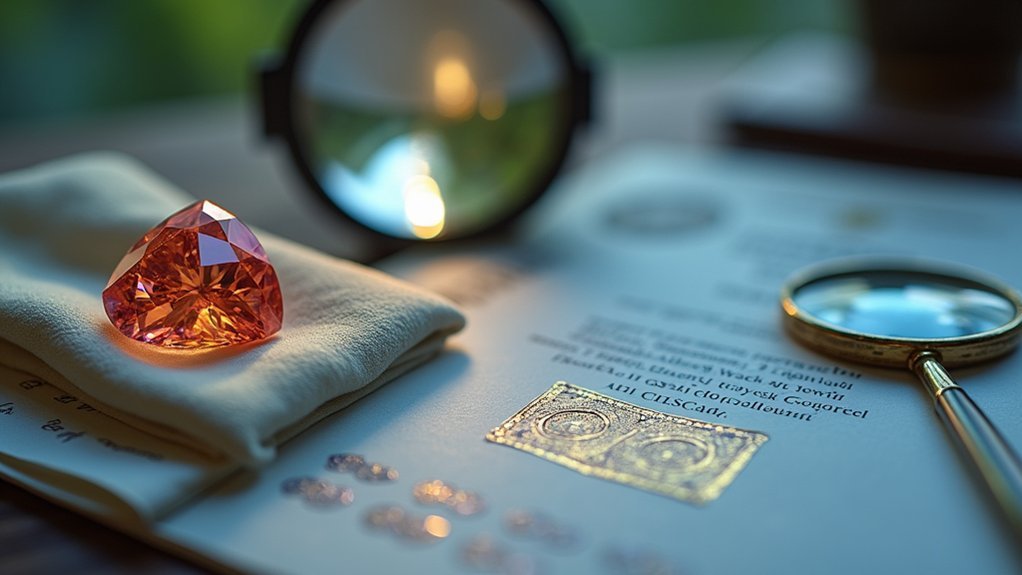
When you’re investing in a valuable gemstone, how can you be certain it’s authentic and accurately described? Understanding gemstone certification standards is vital for protecting your investment.
Reputable organizations like the Gemological Institute of America (GIA) and International Gemological Institute (IGI) establish these standards through rigorous testing protocols.
Your certified gemstone report will detail the stone’s species, variety, shape, cutting style, measurements, color, transparency, and any treatments.
The certification process uses advanced techniques like EDXRF for authenticity determination and geographic origin identification.
Having proper gemstone certification from a recognized Gemological Institute greatly enhances your stone’s market value and legitimacy.
These certificates serve as your guarantee of quality and authenticity, making verification essential before any major purchase.
Recognizing Reputable Gemological Laboratories
When you’re verifying your gemstone’s origin, you’ll need to identify laboratories that meet rigorous accreditation and standards.
Look for certifications from well-established institutions like GIA and IGI, which adhere to international standards set by organizations such as ISO.
These reputable labs use advanced testing methods like EDXRF and laser ablation to provide accurate, non-destructive analysis of your gemstone’s authenticity and origin.
Accreditation and Standards
Since gemstone authenticity depends heavily on professional verification, you’ll need to recognize which laboratories meet established accreditation standards.
Reputable gemological laboratories like GIA and IGI follow strict guidelines that guarantee accurate gemstone identification and reliable grading processes.
Look for accreditation from recognized organizations that validate laboratory competency:
- ANSI certification – Confirms adherence to American National Standards Institute protocols
- ISO accreditation – Indicates compliance with International Organization for Standardization requirements
- Certified gemologists – Staff must complete recognized educational programs and maintain ongoing development
- Detailed reports – Include origin information, treatment history, and thorough quality assessments
- Verification process – Check accreditation status directly with oversight organizations
Always verify a laboratory’s credentials through official oversight bodies to confirm you’re receiving reports from credible sources recognized throughout the gemology industry.
Laboratory Testing Methods
Understanding which testing methods reputable laboratories use helps you evaluate the credibility of gemstone certificates and origin reports.
When you’re working with a gemstone dealer, make sure they use laboratories employing advanced techniques like spectroscopy and EDXRF analysis. These laboratory testing methods examine trace elements within gemstones, accurately determining geographic origins and distinguishing natural stones from synthetic gemstones.
You’ll want certificates that detail thorough testing protocols.
Spectroscopy reveals a gemstone’s internal structure and composition, while EDXRF identifies specific chemical signatures unique to different mining locations. These scientific approaches provide definitive proof of authenticity and origin.
Reputable laboratories follow strict quality standards, making their certificates valuable for insurance, resale, and investment purposes.
Always verify that your chosen laboratory uses these advanced testing methods before accepting any gemstone certification.
Reading and Interpreting Certification Documents
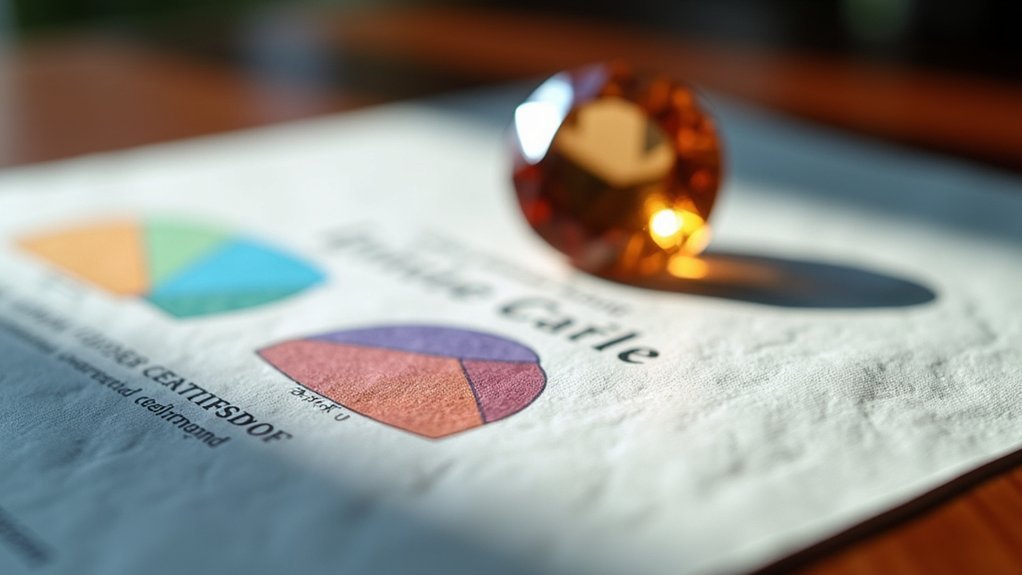
Although certification documents may appear complex at first glance, you’ll find them straightforward once you know what to look for.
These documents contain essential information for verifying your precious stones’ authenticity and origin.
When examining certification documents for your gemstone, focus on these key elements:
- Issuing organization – Look for reputable laboratories like GIA or IGI that use standardized grading systems
- Origin information – Check where the stone was mined or produced, as this affects value and authenticity
- Gemstone characteristics – Verify species, variety, color, clarity, and cut specifications match your stone
- Unique identification number – Cross-reference this against the laboratory’s database for verification
- Treatment notes – Review any enhancements or modifications that impact the gemstone’s value and origin assessment
Verifying Certificate Authenticity Through Laboratory Databases
Once you’ve examined your certification document, you’ll need to verify its authenticity by cross-referencing the report number with the issuing laboratory’s official database.
Laboratory databases maintained by reputable institutions like GIA and IGI store extensive records of gemstone certifications, allowing you to verify authenticity instantly. Simply visit the laboratory’s website and enter your report number into their verification system.
The database will display matching details about your gemstone’s characteristics and geographic origin. If the information aligns with your certificate, you’ve confirmed its legitimacy.
Many laboratories now offer mobile apps for convenient verification, making the process even more streamlined. This cross-reference guarantees you’re dealing with genuine documentation and helps verify your gemstone’s claimed origin through official laboratory records.
Analyzing Chemical Composition Using EDXRF Technology
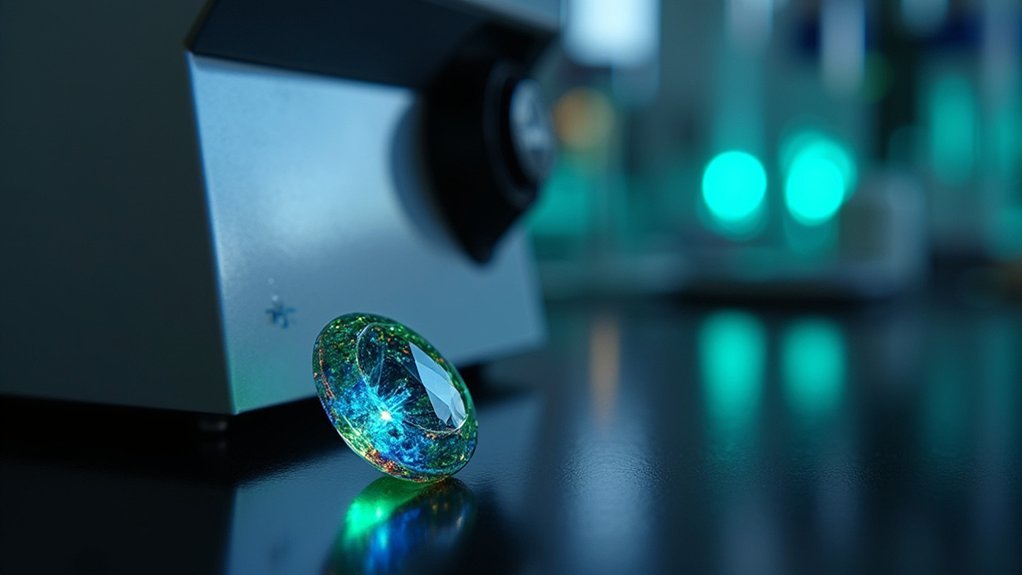
You can verify your gemstone’s authenticity and origin through Energy Dispersive X-ray Fluorescence (EDXRF) technology, which analyzes the stone’s chemical makeup by detecting specific elemental compositions.
This non-destructive process irradiates your gemstone with high-energy X-rays to identify trace elements that act like fingerprints, revealing where the stone originated geographically.
EDXRF testing delivers results within minutes and can distinguish between natural stones from different mines and synthetic alternatives, giving you concrete scientific evidence of your gemstone’s true identity.
EDXRF Analysis Process
When gemologists need to determine a stone’s chemical fingerprint, EDXRF (Energy Dispersive X-ray Fluorescence) technology provides one of the most reliable methods available.
You’ll find this non-destructive technique irradiates your gemstones with high-energy X-rays, causing them to emit fluorescence radiation that reveals their elemental composition. The process helps establish authenticity by detecting trace elements that indicate geographic origin.
The EDXRF analysis follows these key steps:
- Place your gemstone in specialized equipment like the Thermo Scientific ARL QUANT’X EDXRF Spectrometer
- High-energy X-rays bombard the sample surface
- The stone emits characteristic fluorescence radiation
- Detectors measure varying elemental concentrations
- Results appear within minutes, providing chemical data
This rapid analysis differentiates natural from synthetic stones while identifying specific origins like Colombian versus Brazilian emeralds.
Elemental Composition Detection
The elemental composition revealed through EDXRF analysis acts as your gemstone’s chemical passport, containing distinctive signatures that trace back to specific mining locations worldwide.
When you submit your gemstone for testing, the EDXRF technology detects trace elements at varying concentrations within the crystal structure. These elements create unique fingerprints that distinguish natural stones from synthetic alternatives.
You’ll receive detailed reports showing chromium levels in emeralds, titanium content in sapphires, or iron concentrations in garnets. Each element’s presence and quantity tells a story about the geological conditions where your gemstone formed.
EDXRF can identify elements present in parts per million, revealing subtle differences between gemstones from different continents. This precise detection capability makes origin determination remarkably accurate for authentication purposes.
Geographic Origin Identification
Since gemstones from different geographic regions contain distinct chemical signatures, EDXRF technology can pinpoint their origins with remarkable precision.
You’ll find that stones from specific mines carry unique trace element fingerprints that act like geological passports. This technology helps you distinguish between natural and synthetic variants while determining exact provenance.
When you’re analyzing gemstone origins, EDXRF identifies:
- Trace elements specific to geological formations
- Regional mining signatures from different continents
- Chemical markers that distinguish natural from lab-created stones
- Elemental concentrations that vary by geographic location
- Unique mineral compositions tied to specific deposits
Whether you’re examining diamonds score or evaluating stones across the Mohs hardness scale, EDXRF’s non-destructive analysis guarantees your valuable specimens remain intact while providing definitive origin verification for accurate market valuation.
Identifying Geographic Markers in Trace Elements
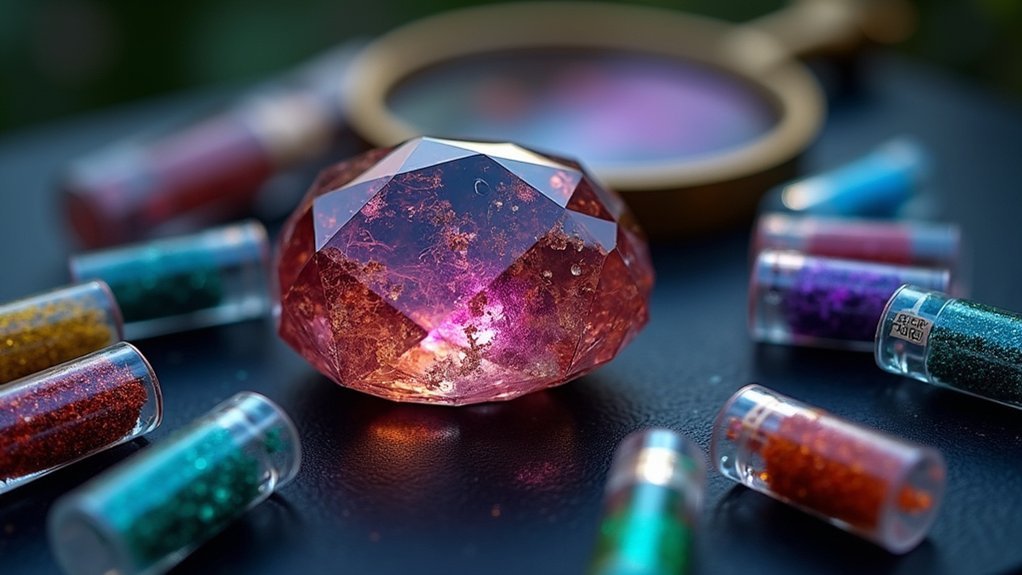
As technology advances in gemological analysis, you’ll find that trace elements serve as distinctive fingerprints revealing where your gemstone originated.
These geographic markers help gemologists identify your stone’s birthplace with remarkable precision.
When you’re examining emeralds, Colombian stones typically contain higher chromium and iron levels compared to Brazilian counterparts.
For rubies, EDXRF technology can detect beryllium traces that indicate Myanmar origins.
Your sapphire’s iron and titanium ratios will differ greatly depending on whether it’s from Kashmir, Sri Lanka, or Madagascar.
Diamond analysis reveals nitrogen or boron concentrations that distinguish South African stones from Australian ones.
Understanding these elemental signatures is vital for accurate appraisal, as geographic origin profoundly impacts your gemstone’s market value and authenticity verification.
Examining Optical Properties and Refractive Index Values
You’ll need to measure your gemstone’s refractive index using a refractometer to compare against documented RI ranges for stones from specific geographic regions.
This testing helps distinguish between natural and synthetic gems while providing essential data for origin verification.
You can also conduct birefringence analysis alongside RI measurements to identify unique optical signatures associated with particular mining locations.
Refractive Index Testing
The refractive index test stands as one of the most reliable methods for determining your gemstone’s true identity and origin. This optical examination measures how light bends when passing through your stone, revealing critical information about its composition.
You’ll need a refractometer to conduct accurate measurements, ensuring your gemstone is clean and properly positioned against the instrument’s crystal for precise readings.
Most gemstones display refractive index values between 1.5 and 1.9, which you can compare against established charts for gemstone identification. The test relies on your stone’s unique optical properties to distinguish it from imitations or treatments.
- Clean your gemstone thoroughly before testing
- Use monochromatic light for most accurate results
- Position the stone correctly against the refractometer’s crystal
- Compare readings with known RI value charts
- Document results for authenticity verification
Birefringence Analysis Methods
Building upon refractive index measurements, birefringence analysis reveals how gemstones split light into two rays traveling at different speeds through the crystal structure.
You’ll measure the difference between maximum and minimum refractive indices by placing your stone on a hemicylinder crystal and taking readings at 30-degree increments. Subtract the lowest value from the highest, rounding to three decimal places for accurate birefringence calculations.
Using a polariscope, you can determine if your gemstone is singly refractive (SR), doubly refractive (DR), or aggregate (AGG) based on alternating light and dark patterns.
These optical properties help identify specific minerals like calcite, quartz, and tourmaline, each displaying distinct behaviors. Combined with RI values, birefringence analysis greatly enhances gemstone identification accuracy.
Evaluating Physical Characteristics Unique to Regional Sources
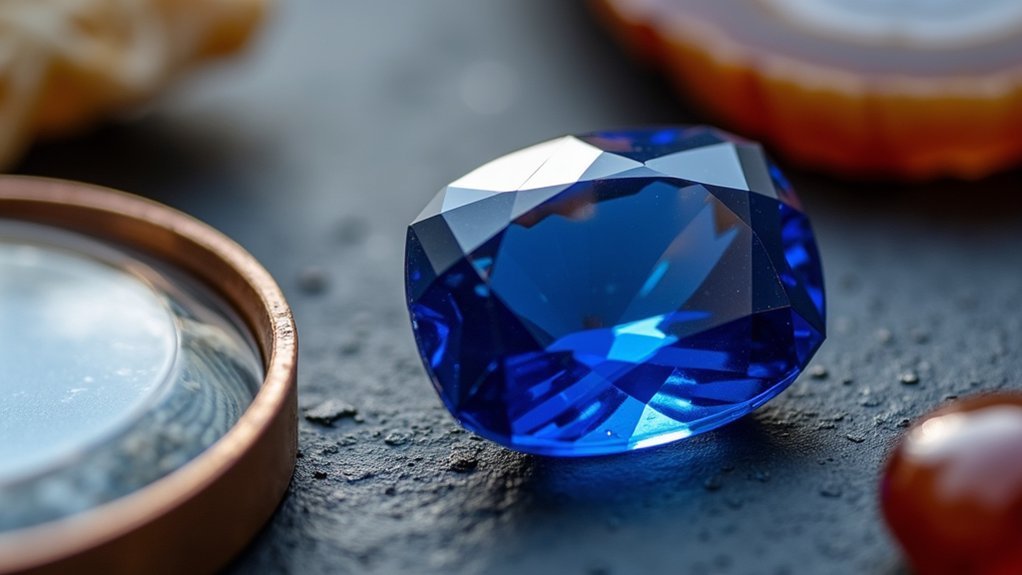
How can gemstone enthusiasts distinguish authentic regional specimens from the countless stones flooding today’s market?
You’ll need to examine specific physical characteristics that reveal geographic origins of colored stones. Regional sources produce distinct visual signatures that help identify authentic specimens.
Colombian emeralds display vivid green coloration with remarkably fewer inclusions than emeralds from other locations.
Burmese rubies exhibit deep red hues with blue undertones, creating the coveted “pigeon’s blood” appearance.
Kashmir sapphires showcase velvety textures and intense blue colors with unique luminous qualities under light due to high iron content.
- Colombian emeralds: Vivid green with minimal inclusions
- Burmese rubies: Deep red with blue undertones (“pigeon’s blood”)
- Kashmir sapphires: Velvety appearance with intense blue glow
- Tanzanian tsavorites: Brilliant green with exceptional clarity
- Zambian emeralds: Distinct chromium content detectable through analysis
Researching Seller Credentials and Supply Chain Documentation
Beyond examining physical characteristics, you must investigate the seller’s credentials and documentation trail to authenticate your gemstone’s origin.
Start by verifying their membership in reputable organizations like GIA or IGI, which indicates ethical practices and expertise. Request supply chain documentation including invoices and certificates of authenticity to trace the stone’s journey. These steps to identify legitimate sellers are often used by experienced collectors.
Verify seller credentials through GIA or IGI membership and request complete supply chain documentation to establish authenticity and expertise.
Investigate the seller’s reputation through customer reviews across multiple platforms to gauge their reliability.
Look for third-party certifications providing detailed origin, treatment, and quality information. Confirm the seller can provide gemstone origin reports specifying geographic sources. This documentation helps you make informed decisions about authenticity and market value, establishing vital legitimacy for your investment.
Cross-Referencing Multiple Verification Methods
While documentation provides essential background information, you’ll need to combine multiple scientific testing methods to definitively verify your gemstone’s origin. No single test can provide complete certainty, so you’ll want to cross-reference results from various analytical techniques to build a thorough profile of your stone.
Start with Energy Dispersive X-ray Fluorescence (EDXRF) to analyze elemental composition and identify trace elements unique to specific geographic locations. Then measure your gemstone’s refractive index and compare it against established charts that correlate optical properties with known origins.
- Use a polariscope to determine birefringence and other optical characteristics
- Compare color and clarity against GIA or IGI certification reports
- Cross-reference EDXRF results with regional trace element databases
- Verify refractive index measurements match known origin parameters
- Consult gemology experts to interpret combined findings
Understanding Synthetic Vs Natural Stone Indicators
Before you can determine your gemstone’s geographic origin, you’ll need to establish whether it’s natural or synthetic, since lab-created stones won’t have meaningful location data.
Natural gemstones typically display unique inclusions and imperfections that form during their geological creation, while synthetic stones often show fewer or distinctly different inclusion patterns.
Natural gemstones reveal their authentic origins through distinctive inclusions and imperfections that synthetic stones simply cannot replicate.
You’ll notice natural stones exhibit color and clarity variations due to their formation processes, whereas lab-created gems tend to appear more uniform.
A refractometer can reveal differences in refractive index between natural and synthetic stones.
For definitive verification, obtain certification from reputable organizations like GIA or IGI.
Advanced testing using EDXRF technology can identify trace elements unique to natural stones, providing conclusive evidence of authenticity.
Documenting Provenance Through Purchase Records
Three key documents form the foundation of gemstone provenance verification: your original purchase receipt, any accompanying certificates, and detailed seller information.
These records create an authentication trail that’s essential for confirming your gemstone’s legitimacy and value.
Your purchase receipt should include extensive details beyond just the price. Reputable dealers typically provide source information and certification details on sales documentation.
You’ll want to maintain organized records with dates, seller contact information, and any special provenance claims.
- Keep original receipts with detailed gemstone descriptions and source information
- Store certificates from recognized gemological institutions separately from receipts
- Document seller credentials, business licenses, and contact details
- Record specific treatment disclosures and enhancement information
- Photograph all documentation for digital backup storage
This documentation greatly enhances resale value and market desirability.
Working With Professional Gemologists for Complex Cases
When standard documentation falls short or your gemstone exhibits unusual characteristics that challenge conventional identification methods, enlisting a certified gemologist becomes essential.
Professional gemologists employ advanced techniques like EDXRF and laser ablation to analyze composition and pinpoint geographic origin with remarkable accuracy. You’ll want to work with gemologists affiliated with reputable organizations, guaranteeing they follow recognized standards and practices.
Advanced gemological techniques like EDXRF and laser ablation enable certified professionals to determine composition and geographic origin with exceptional precision.
Their specialized equipment and expertise prove invaluable when evaluating stones with complex characteristics that standard methods can’t resolve.
Professional gemologists issue detailed certification reports documenting origin, treatments, and authenticity, giving you confidence in your stone’s credentials.
For disputed cases involving authenticity or origin questions, their professional evaluation can resolve conflicts and guarantee fair marketplace valuation.
Frequently Asked Questions
How to Verify Gemstone?
You’ll verify your gemstone’s authenticity using EDXRF technology for non-destructive elemental analysis. Check for GIA or IGI certification, compare refractive index measurements, and consult professional gemologists for advanced testing like laser ablation mass spectrometry.
How to Check Original Stone at Home?
You can check your stone’s authenticity by examining its color and clarity, conducting hardness tests, using a magnifying glass for internal patterns, performing careful scratch tests, and verifying certification documentation.
How Much Does It Cost to Test a Gemstone?
You’ll pay between $50 to $300 for gemstone testing, depending on the method and laboratory you choose. EDXRF testing typically costs $150 to $250, while thorough identification reports range from $100 to $300.
Where to Authenticate Gems?
You’ll find authentication at reputable gemological laboratories like GIA or IGI. Visit local gem shows where gemologists offer on-site services, or search online gemology platforms that connect you with certified professionals.
In Summary
You’ve now got the essential tools to verify your gemstone’s origin confidently. Don’t rely on just one method—combine certification checks, laboratory analysis, and professional consultation for the most accurate results. Remember that authentic documentation and reputable sources are your best allies in this process. When you’re dealing with valuable stones, it’s always worth investing in proper verification. You’ll protect your investment and guarantee you’re getting exactly what you’ve paid for.

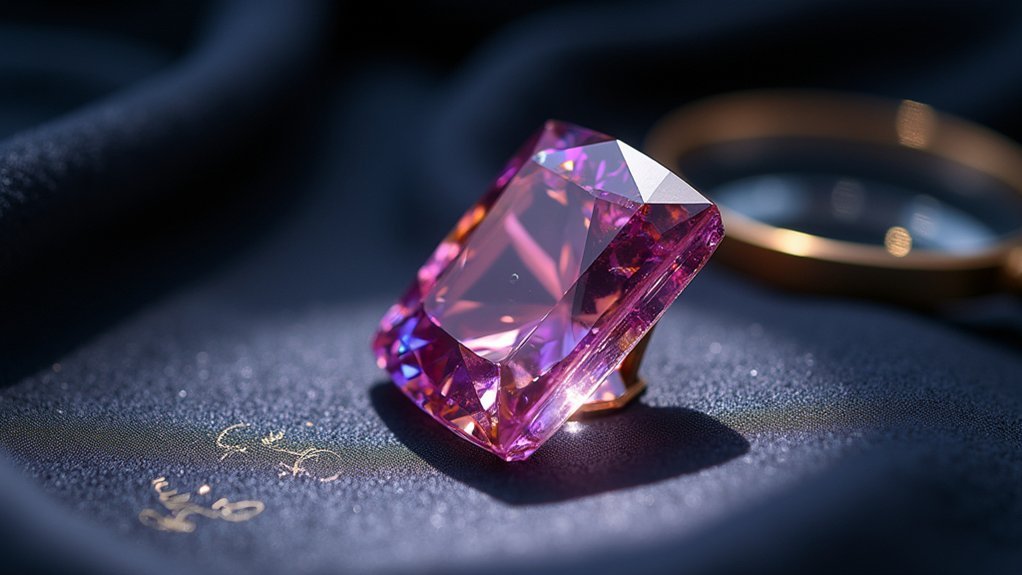



Leave a Reply